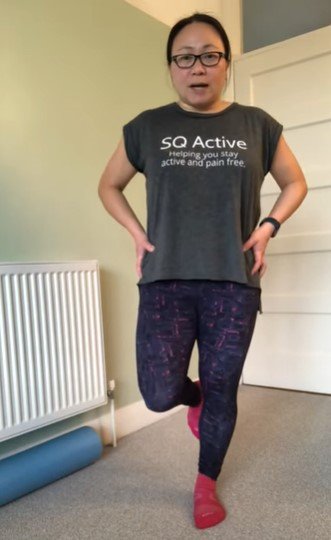Did you know balance is used as an indicator of life expectancy for those aged 50+?
Take your shoes off, put your hands on your hips and and stand on one leg. If you are over 50, can you do it for at least 10 seconds? If you’re younger, you should be able to balance for longer.
If you found balancing easy with your eyes open, test with your eyes closed.
Single leg balance
How can balance predict life expectancy?
Activities such as walking up stairs, getting out of a car, getting out of a bath require you balance on one leg. The inability to balance for at least 10 seconds means you are more likely to lose balance and fall. Falls are a major health risk for older adults.
So how is your balance? Test both legs.
Balance is not solely about muscle engagement, we also rely on feedback from our eyes and ears, hence balance becomes more of an issue later in life. Our vision deteriorates and our hearing goes. Hearing loss can be related to issues in the inner ear, which is responsible for balance.
Did you find it harder to balance with your eyes closed?
If you can no longer rely on your eyes or ears, what can you rely on?
Regardless of age, you can improve balance through better core muscle engagement and feedback from your feet.
Your foot is made up of 33 joints, 26 bones, and over a hundred muscles, tendons, and ligaments. Your feet support you and help you with balance, they also transmit force and help you move.
They play a demanding role, so their health is of great importance - do you ever exercise the muscles in your foot?
Feet are often neglected.
If you can't do the movements in the video, it's time to get started....
If you spend all day in shoes, take them off and walk around with bare feet.
What other muscles do you need to engage?
Strengthening your core and glutes will also help with your balance as will improving your ankle mobility.
Is your ankle moving freely or does your ankle move too much?
I am a Personal Trainer, Movement Coach, Soft Tissue Therapist who helps people reduce their muscular aches and pains so they can live active, enjoyable lives. As with everything, prevention should always be a priority, so I work with clients to reduce or resolve their issues whilst looking at how they can prevent reoccurrence and prevent future issues.
Mobility and movement can be improved regardless of age, the earlier your start the better though, so if you would like to discuss this or anything movement or fitness related, please book your complimentary exploratory call now.



